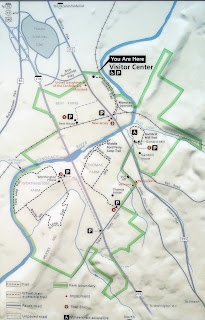My Hubby and I share a common interest in history. He tracks down historic trains and I learn where the historic schools are. Today, it’s all about the trains.
After we leave
Horseshoe Curve (near Altoona),
we drive to the Allegheny Portage Railroad NHS.
The Visitor
Center closed at 5:00
p.m. We arrive 45 minutes too late to
see what is inside it but the park grounds are open until sunset.
Visitor Center
Display
signs along the trail will provide us with a better understanding on how and
why this system was built.
NPS Map
We begin by walking
the boardwalk trail. It is an easy walk through the woods to the Engine House and
Inclined Plane No. 6.
A wooden deck offers a view of the remains of the incline. An exhibit sign explains how the “steps” of
the incline plane system works. “The Portage consisted of 11 relatively level
horizontal passages that were linked by 10 'steep' inclined planes.”*
Trail
Remains of Inclined Plane No. 6
NPS Map
On
the right side of the wooden deck is the Engine House. We peek through the windows and see the machinery that hoisted and
lowered on the inclines. “At the head of each incline was an engine
house built of wood. It contained the
stationary steam engine, wheels, gears, hydraulic pistons, vertical 8-foot
wheels, horizontal 9-foot by 7-inch sheaves, and wells approximately 3 feet
wide and 8 feet deep.”*
Engine House 6 Exhibit Building
On the left side of the wooden
deck is the beginning of a 1/3 mile trail (one way) to the 60.4’ long Skew
Arch. A skew arch “is a method of
construction that enables an arch bridge to span an obstacle at some
angle other than a right angle.”*
We hike the downhill trail to the road
(Hwy 22) to see the railroad bridge. It's a steady uphill hike back to the Engine House.
Trail to Skew Arch
Skew Arch
Trail View of Engine House
Near the Engine House
is the two-story Lemon House. It was a popular stop along the train route. The former tavern now serves as a historical
museum operated by the National Park Service.
It is unfortunate that we arrived to late in the day to see inside the
museum.
Lemon House/Tavern
The
Park closes at sunset and it’s time for us to leave for our next destination –
the historic Old Bedford
Village (Bedford, PA).
If you
enjoy trains, I invite you to view my other blog posts on historic train
sites/museums by clicking on the following links:
Altoona (population 40,796 in 2013) has a
wide variety of lodging and dining options.
Bedford (population 2,781 in 2013) has fewer selections than
Altoona but still offers
some good choices.
Since opinions,
preferences, and budgets vary, I recommend checking a trusted travel source for
current reviews on dining and lodging options.
For a list of historic railroad
hotels, trackside motels, train themed B&B’s, and restaurants in former and
active train stations, click on the following link:
This list will include the Red
Caboose Motel (Ronks/Strasburg, PA). Travel
reviews weren’t very favorable prior to February of 2016. That is when the caboose motel transferred
ownership and reviews over the last couple months were better. So, during our May 2016 visit, we thought we
would stay one night ($150 + tax) at this unique lodging. We weren't very impressed but kids seem to love it.
Red Caboose Motel
LOCATION: Allegheny Portage Railroad National Historic Site (NHS), 110 Federal Park Road, Gallitzin Township, Pennsylvania (USA). It is located about 15 miles from Altoona and 40 miles from Bedford, PA
Telephone: (814) 886-6150
HOURS/FEES: The Visitor Center and buildings are open daily from 9:00 a.m. to 5:00 p.m. The park grounds are open daily from sunrise to sunset. However, Park hours can change due to holidays and inclement weather. The entrance fee is $5 per person (children under the age of 15 are admitted free). At this time, the Park does not accept credit cards. For more information, please click on the “Plan Your Visit” link at the bottom of this post.
BACKGROUND: According to Wikipedia, “The Allegheny Portage Railroad was the first railroad constructed through the Allegheny Mountains in central Pennsylvania. Construction began in 1831 and took three years to complete. It operated from 1834 to 1854. Considered a technological marvel in its day, it played a critical role in opening the interior of the United States beyond the Appalachian Mountains to settlement and commerce. In 1854 the portage railroad was rendered obsolete by construction of a locomotive railroad over the Alleghenies by the Pennsylvania Railroad, a private company. A skew arch bridge, a masterwork of cut stone construction, is another feature of the site.” This 1,296-acre park was established on August 31, 1964. The Allegheny Portage Railroad NHS was designated a National Historic Landmark on December 29, 1962 and was listed on the National Register of Historic Places on October 15, 1966.
Family vacations created
some of my favorite memories. To start
planning your memorable trip to Allegheny Railroad Portage NHS, click on the “Plan
Your Visit” link below:
*National Park Service (NPS) Source










